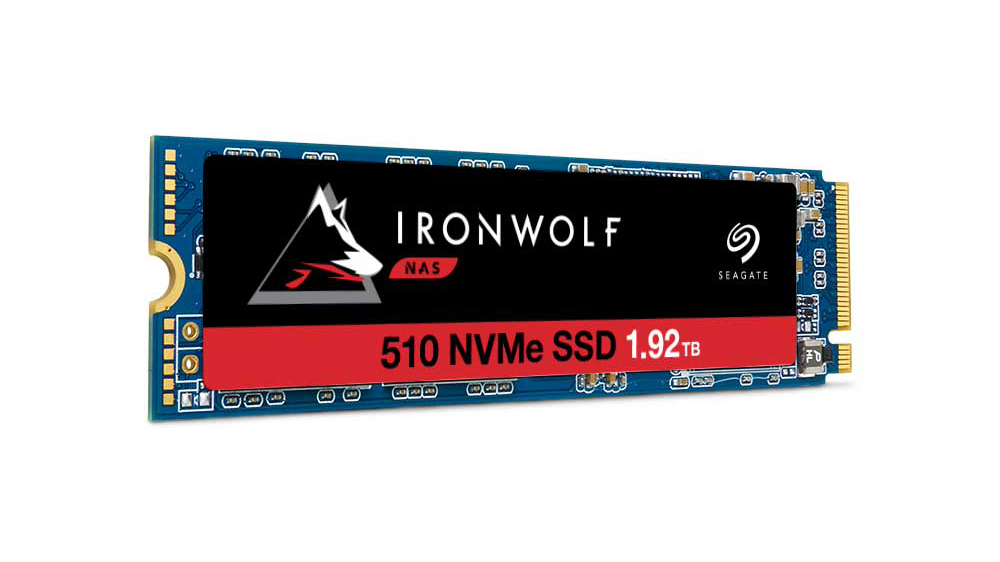Seagate IronWolf 510 ZP1920NM30001 (1.92TB) review: Built for business
Built for SMB NAS caching, this NVMe drive is pricey but has a massive lifespan


-
+
Massive 3500 TBW life expectancy
-
+
Low power consumption
-
-
Expensive

The Seagate IronWolf range is built for NAS (network-attached storage) devices in multi-user environments. It’s aimed at small and medium enterprise deployments and intended to be used as a space-efficient caching drive in devices that support cache acceleration, such as NAS devices and servers with M.2. slots.
Alternatively, its relatively compact, 80mm long, M.2-2280 form factormeans that it could also be used as standard storage in a server, workstation or a NAS with M.2 slots.
Unsurprisingly given its intended purposes, it’s built for endurance, too. Seagate quotes a TBW (total bytes written) lifespan of 3,500TB and backs that up with a five-year warranty and a three-year data recovery plan.
As a caching drive to improve access speeds, the NVMe range’s top-tier 1.92TB Seagate IronWolf 510 ZP1920NM30001-2S9303 is well suited to use alongside around 40TB to 80TB of RAID 1 storage, for example.
Seagate IronWolf 510 ZP1920NM30001 (1.92TB) review: Performance
It uses Triple Layer Cells – which means that three bits are stored per NAND cell, in common with most business and consumer desktop SSDs - and supports NVMe 1.3 on the PCIe x3.0 M.2 interface. These are key factors in performance, and its scores in our benchmark tests reflect them.
A fresh drive connected to a Linux workstation with an AMD Ryzen 3600X CPU and X570 motherboard chipset gave us a sequential write speed of 939MB/sec and a sequential read of 777MB/sec. We got a random write speed of 907MB/sec and random read speed of 846MB/sec.
We run our tests twice, once on a fresh drive, and again on a drive that’s been erased, as a rough indicator of the potential performance impact of using a drive that’s regularly filled up. This time, we got a sequential write speed of 894MB/sec and a random write of 854MB/sec, representing a slowdown of 53 MB/sec and 45MB/sec, respectively.
Seagate quotes a relatively low average maximum power draw of 6W and idle power consumption of 2W for the 1.92TB IronWolf 510. Management and disk health monitoring tools are available for Windows and Linux, and on compatible NAS devices, including selected models by Synology, QNAP and QSAN, you’ll be able to monitor the disk using Seagate’s IronWolf Health Management suite.
Seagate IronWolf 510 ZP1920NM30001 (1.92TB) review: Verdict
The high capacity, extended durability and commensurate £356 price mean that the IronWolf 510 is likely to be overkill for file server caching in your average office environment, but if you regularly access large amounts of data, it has the performance and life expectancy that you’ll need, whether you’re handling video, images or big data.
Get the ITPro daily newsletter
Sign up today and you will receive a free copy of our Future Focus 2025 report - the leading guidance on AI, cybersecurity and other IT challenges as per 700+ senior executives
K.G. is a journalist, technical writer, developer and software preservationist. Alongside the accumulated experience of over 20 years spent working with Linux and other free/libre/open source software, their areas of special interest include IT security, anti-malware and antivirus, VPNs, identity and password management, SaaS infrastructure and its alternatives.
You can get in touch with K.G. via email at reviews@kgorphanides.com.
-
 ‘Phishing kits are a force multiplier': Cheap cyber crime kits can be bought on the dark web for less than $25 – and experts warn it’s lowering the barrier of entry for amateur hackers
‘Phishing kits are a force multiplier': Cheap cyber crime kits can be bought on the dark web for less than $25 – and experts warn it’s lowering the barrier of entry for amateur hackersNews Research from NordVPN shows phishing kits are now widely available on the dark web and via messaging apps like Telegram, and are often selling for less than $25.
By Emma Woollacott Published
-
 Redis unveils new tools for developers working on AI applications
Redis unveils new tools for developers working on AI applicationsNews Redis has announced new tools aimed at making it easier for AI developers to build applications and optimize large language model (LLM) outputs.
By Ross Kelly Published
-
 Google layoffs continue with "hundreds" cut from Chrome, Android, and Pixel teams
Google layoffs continue with "hundreds" cut from Chrome, Android, and Pixel teamsNews The tech giant's efficiency drive enters a third year with devices teams the latest target
By Bobby Hellard Published